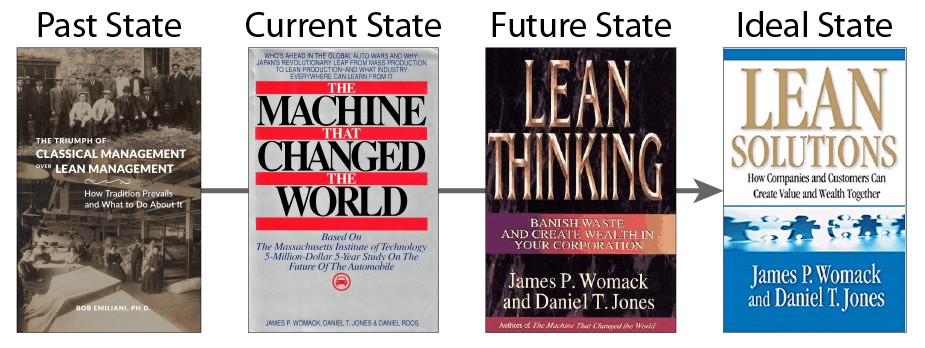In Lean management, we speak of the current state, the future state, and the ideal state. But what about the past state? Why isn’t the past state also of interest? It should be, because the past informs the present — the current state — which in turn determines the probability of achieving desire future states. Unfortunately, the past state is embedded in the current state to a far greater extent than you can imagine. As a result, achieving future states turns out to be a low probability endeavor, just as most of us have learned from our own experiences with Lean.

Lean movement leaders have touched upon the past to a very limited degree, mainly in the context of earlier work that laid the foundation for today’s progressive management systems as defined by Toyota’s management system (TMS) and its derivative, Lean management (LM). They focused on Scientific Management and the work of pioneers such as Frederick Winslow Taylor, Frank and Lillian Gilbreth, and their colleagues. Generally, they did a terrible job of understanding Taylor’s work, in particular (see examples here, here, and here), because they ignored primary sources of information and instead relied on secondary and tertiary sources (which incorrectly re-interpreted original sources).
Taylor, Gilbreth, and the others who joined them in creating Scientific Management and applying it in industry encountered the same problems that TMS and LM have encountered over the last 30 or 40 years. That repetition of history signals a thoroughly incomplete understanding of the past — the long ago past, well before early 20th century Scientific Management. The past state must be better understood in order to explain why TMS and LM, and SM before them, struggled to gain widespread acceptance among the heads of organizations — especially business leaders. For if business leaders do not accept progressive management, then it is unlikely that other leaders will. Business leaders are highly respected in society, and what they do is emulated by other leaders, whether they are in charge of non-profit, non-government, or government organizations.
Lean was thought to be the foremost method for replacing “command-and-control” leadership. It was assumed that leaders — business leaders in particular — want to become servant leaders. And it was assumed that employees want a better work experience compared to what they already have. It turns out that command-and-control remains popular among business leaders, while employees are happy (or happy enough) with that type of leader to be unwilling to demand change. So, both leaders and employees seem, overall, content with conservative classical management. But why is this so? Why is progressive management unappealing to most leaders and most employees?
This was the great mystery that, in an ideal state, would have been unraveled prior to introducing Lean to the public in the fall of 1988, so that desired future states could be achieved on a wider scale. But, the current state offered a different perspective. It said: “The times we live in, 1988, are different than 1911, and so we need not consider the past as we move forward into the future.” That was a big mistake. The view was: “We don’t care how the current state came to be. It is not important to our task of promoting Lean management.” Ah, but decades later, we now know how short sighted this well-intentioned view was. Knowing how the current state came to be is key that unlocks Lean success.
Scientific Management, Toyota management, and Lean management all have at their core the idea of bringing scientific thinking to the management of organizations. The twin assumption were: 1) leaders wanted to become better leaders, and 2) leaders would happily accept scientific thinking as the principal means for becoming better leaders. These were bad assumptions in 1911. These were bad assumptions in 1988. And they remain bad assumptions today. But why? Again, the past state informs the current state, which determines the probability of achieving desired future states. Yet, if we now take the time to understand the past state, we will be better able to realize future states — and maybe even ideal states.
So what is it about that past state that you need to know? My book, The Triumph of Classical Management Over Lean Management: How Tradition Prevails and What to Do About It will inform you of the past state — the way past, and how it presents itself today. You’ll learn why most leaders are not interested in becoming better leaders, why they are not interested in scientific thinking, and why they remain committed to classical management. If you don’t take an interest in the past, the future states that you are lucky enough to create will be ephemeral. My hope is that you want to learn more than what you know now about the past state to substantially improve the probability of achieving desired future states.
